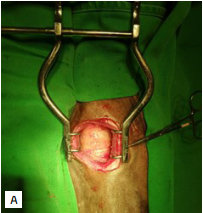Permanent tracheostomy in a horse: a case report
DOI:
https://doi.org/10.21708/avb.2022.16.1.10246Abstract
Problems related to the locomotor and gastrointestinal systems correspond to the highest percentage of clinical cases. However, diseases related to the respiratory system can result in low animal performance or even the animal's removal from athletic life. This paper aims to report a case of permanent tracheotomy in a horse. The animal was treated at the Jerônimo Dix-Huit Rosado Maia Veterinary Hospital - HOVET, with respiratory noise and dyspnea claims. In the anamnesis, the owner reported that the animal had been presenting respiratory difficulty for 20 days. On physical examination, respiratory noise and dyspnea were noted. Endoscopy was performed, from which a marked decrease in the arytenoid cartilage movement on the right and left sides was noted. It was possible to diagnose a stage IV case of bilateral laryngeal hemiplegia, combining clinical signs with endoscopy findings. Thus, the surgical treatment of permanent tracheostomy was chosen. After surgery, drug therapy using antibiotics and anti-inflammatory drugs was performed. In addition, a #6 metal tracheostomy cannula was inserted. After 36 days of hospitalization, the animal was discharged with regression of clinical signs.
Downloads

Downloads
Pubblicato
Fascicolo
Sezione
Licenza
Autores que publicam na Acta Veterinaria Brasilica concordam com os seguintes termos: a) Autores mantém os direitos autorais e concedem à revista o direito de primeira publicação, com o trabalho simultaneamente licenciado sob a Licença Creative Commons Attribution que permite o compartilhamento do trabalho com reconhecimento da autoria e publicação inicial nesta revista. b) Autores têm autorização para assumir contratos adicionais separadamente, para distribuição não-exclusiva da versão do trabalho publicada nesta revista (ex.: publicar em repositório institucional ou como capítulo de livro), com reconhecimento de autoria e publicação inicial nesta revista. c) Autores têm permissão e são estimulados a publicar e distribuir seu trabalho online (ex.: em repositórios institucionais ou na sua página pessoal) a qualquer ponto antes ou durante o processo editorial, já que isso pode gerar alterações produtivas, bem como aumentar o impacto e a citação do trabalho publicado (Veja O Efeito do Acesso Livre).


 Esta obra está licenciada com uma Licença
Esta obra está licenciada com uma Licença 